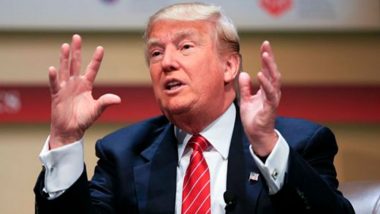Washington, January 18: Declaring that "space is a new war-fighting domain", President Donald Trump has announced an ambitious plan to develop a space-based anti-missile defence system to track and destroy weapons-bearing rockets.
In a speech at the Pentagon on Thursday, Trump said: "It's new technology. It's ultimately going to be a very, very big part of our defence and, obviously, of our offence." While mired in a partial government shutdown, he said that his "upcoming budget will invest in a space-based missile defence layer".
Trump had proposed last year the creation of a Space Force as a new branch of the military like the Air Force, Navy and Army.
He said: "We will recognise that space is a new war-fighting domain, with the Space Force leading the way."
Trump's speech and the Missile Defence Review document that he and Vice President Mike Pence presented at the military headquarters, did not give many details about the new space strategy and it was not clear if the plans called for placing in space the weapons to destroy the missiles.
If that were to happen, it could start a new arms race but not violate the 1966 Outer Space Treaty that only bans placing nuclear and other mass-destruction weapons in outer space.
The US has opposed a proposal by Russia and China to ban all weapons in space. It voted against a UN General Assembly resolution on ensuring that weapons were not placed in space.
Trump did not mention who would be the targets of programme, only saying: "Regardless of the missile type or the geographic origins of the attack, we will ensure that enemy missiles find no sanctuary on Earth or in the skies above."
He also said that it would guard against accidental missile launches by others. But he mentioned Iran on which he has focused particular animosity, withdrawing from an international agreement for Tehran to end a nuclear weapon programmes.
The President referred to its recent failed rocket launch with satellites and warned that the technology and the lessons from the failure could be used to develop the intercontinental ballistic missiles.
North Korean leader Kim Jong-un has in the past threatened that his country had missiles that could hit major US cities. He agreed to end the missile programme during his summit with Trump in Singapore last June and has since made a show of destroying missile sites.
Trump has set the course for a renewed arms race with Russia by withdrawing from the Intermediate-Range Nuclear Forces Treaty under which both countries agreed not to develop or deploy missiles with ranges of 500 to 5,500 km.
He said at the Pentagon: "We are committed to establishing a missile defence programme that can shield every city in the US. And we will never negotiate away our right to do this."
The space-based anti-missile system he proposed has echoes of the Strategic Defence Initiative -- nicknamed the "Star Wars" programme -- announced by former President Ronald Reagan in the 1980s. The space component of it has not made headway.
The role of Trump's Space Force as a new branch of the military was not clear. Announcing it he made a vague assertion, "We must have American dominance in space".
If it is created, it would likely protect satellites and space vehicles. While Trump's defence focus on space, the withdrawal of US troops from Syria ordered by him has come in for renewed scrutiny after four Americans were killed there by the Islamic State terror group, which he said had been vanquished.
Two of those killed were military personnel, while another was a civilian defence employee and the other was a civilian contractor. James Mattis had resigned as Defence Secretary because of his difference with Trump on withdrawing US troops from Syria and Afghanistan, which has been widely criticised.
(The above story first appeared on LatestLY on Jan 18, 2019 02:15 PM IST. For more news and updates on politics, world, sports, entertainment and lifestyle, log on to our website latestly.com).













 Quickly
Quickly











